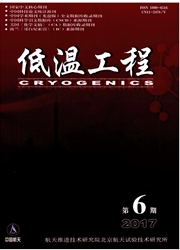

 中文摘要:
中文摘要:
增加接触角是提高表面抗结冰结霜能力的重要方法。借助电化学加工和氟化处理获得铝基体超疏水表面,该表面具有二元微纳米复合结构,干燥时水滴在其上的接触角为160°,滚动角小于5°,处于Cassie.Baxter状态。在自制的半导体制冷台上,观测冷表面温度为-5.2℃时,铝基体超疏水表面的结霜过程,并将其与普通铝表面进行了对比,发现铝基体超疏水表面的四周边缘处先出现霜晶并逐渐蔓延到整个表面,与普通铝表面相比具有显著的抗结冰结霜性能。最后对铝基体超疏水表面的边缘效应和抗结冰结霜机理进行了分析。
 英文摘要:
英文摘要:
Increasement of contact angle is an important approach to improve ice and frost repellency of surfaces. The superhydrophobic surface on aluminum fabricated by electrochemical corrosion and fluorination demonstrates Cassie-Baxter condition with water contact angle of 160° and contact angle hysteresis lower than 5°. Frosting process on the superhydrophobic surface was observed and compared with ordinary alumi- num surface on the semiconductor refrigerator when the surface temperature was - 5.2 ℃. Frost crystals appear arounding the edges of the superhydrophobic surface firstly, then spread gradually to the entire surface. The superhydrophobic surface demonstrates the anti-icing and frosting capability eminently compared with ordinary aluminum surface. Finally, edge effects and the ice and frost repellency mechanism of superhydrophobic surface on aluminum was discussed.
 同期刊论文项目
同期刊论文项目
 同项目期刊论文
同项目期刊论文
 Fabrication of superhydrophobic Cu surfaces on Al substrates via a facile chemical deposition proces
Fabrication of superhydrophobic Cu surfaces on Al substrates via a facile chemical deposition proces Fabrication of superhydrophobic surfaces on Mg alloy substrates via primary cell corrosion and fluor
Fabrication of superhydrophobic surfaces on Mg alloy substrates via primary cell corrosion and fluor Preparation of superhydrophobic titanium surfaces via electrochemical etching and fluorosilane modif
Preparation of superhydrophobic titanium surfaces via electrochemical etching and fluorosilane modif Fabrication of superhydrophobic surfaces with high adhesive forces towards water on steel substrates
Fabrication of superhydrophobic surfaces with high adhesive forces towards water on steel substrates A rapid two-step electroless deposition process to fabricate superhydrophobic coatings on steel subs
A rapid two-step electroless deposition process to fabricate superhydrophobic coatings on steel subs Fabrication of Low-adhesive Superhydrophobic Al Surfaces via Self-assembled Primary Cell Assisted Et
Fabrication of Low-adhesive Superhydrophobic Al Surfaces via Self-assembled Primary Cell Assisted Et Loading capacity of a self-assembled superhydrophobic boat array fabricated via electrochemical meth
Loading capacity of a self-assembled superhydrophobic boat array fabricated via electrochemical meth Ultrafast fabrication of rough structures required by superhydrophobic surfaces on Al substrates usi
Ultrafast fabrication of rough structures required by superhydrophobic surfaces on Al substrates usi Electrochemical machining of super-hydrophobic Al surfaces and effect of processing parameters on we
Electrochemical machining of super-hydrophobic Al surfaces and effect of processing parameters on we 期刊信息
期刊信息
